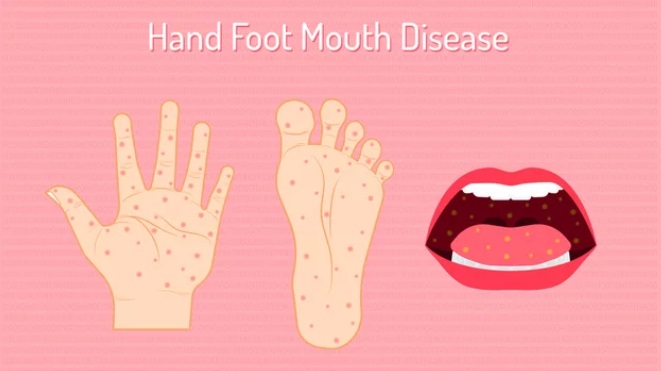Introduction
Hand, foot, and mouth disease is a mild but highly contagious viral infection commonly found in young children.
The infection primarily affects children younger than the age of 10 because they do not yet have immunity to the viruses that cause it, however, it can also occur in adolescents and occasionally in adults.
The infection is NOT RELATED to hoof-and-mouth disease, which is an infectious viral disease that affects livestock, such as cows, sheep, and pigs.
The two are different, animals do not contract or transmit HFMD, and humans do not contract or transmit the animal disease. Hand, foot, and mouth diseases occur in all areas of the world, usually during the spring, summer, and fall months.
Causes of HAND, FOOT, and MOUTH DISEASE (HFMD)-
The major cause of HFMD is the coxsackievirus A16, which belongs to a group of viruses termed nonpolio enterovirus.
The second most common pathogen that may be responsible for the infection is enterovirus 17. Other strains of enteroviruses can sometimes also be responsible.
How are Hand, foot, and Mouth diseases TRANSMITTED?
The infection is highly contagious and is transmitted by direct contact or oral ingestion of infected –
1. Person’s saliva
2. Fluid from blisters
3. Stool
4. Cough or sneeze
5. Nasal secretion
6. Throat discharge
7. Touching objects or surfaces that have the virus on them.
8. HFMD can spread quickly in childcare settings because of –
– frequent diaper changes,
– potty training, and also because
– little children often put their hands in their mouths.
What are the SYMPTOMS of Hand, Foot, and Mouth Disease?
The incubation period, which is the time between the infection and onset of symptoms, is usually between 3 to 6 days.
It typically begins with a fever and the child feeling unwell. This is followed one or two days later by flat discolored spots or bumps that may blister on the hands, feet, and mouth, and occasionally buttocks and the groin area.
As the incubation period is 3-6 days, hence the signs and symptoms normally appear 3–6 days after exposure to the virus. The rash generally resolves on its own in about a week. There are chances of fingernail and toenail loss that may occur a few weeks later, but they will regrow with time
1. Fever
2. Sore throat
3. Loss of appetite
4. Irritability in infants and toddlers
5. Painful ulcers (Lesions may also develop in or around the nose or mouth).
A rash with painful tiny blisters may start to show up in the mouth (including the sides of the tongue, gums, top of the mouth, and on the inner cheeks), palms of hands, fingers, buttocks, and the soles of feet.
Most children with HFMD will also have PAINFUL SORES in the mouth. Check their tongue — including the sides — and throat.
How are Hand, Foot, and Mouth diseases diagnosed?
To make a diagnosis, the doctor will evaluate the age of the affected person, the pattern of signs and symptoms, and the appearance of the rash or sores. This will help aid in distinguishing HFMD from other types of viral infections. To determine the strain of the virus causing the illness, the doctor may take a throat swab or stool specimen and send it to the laboratory. Early detection of the infection is important in preventing an outbreak in the pediatric population.
What is the TREATMENT of Hand, foot, and Mouth Disease?
No specific treatment option exists for the infection. Signs and symptoms usually clear up within 10 days.
To help reduce the pain of mouth sores, a topical oral anesthetic may be recommended.
Over-the-counter pain medications such as acetaminophen or ibuprofen may help relieve general discomfort.
In rare cases, an infected person may develop viral meningitis, which is inflammation of the tissue covering the brain and the spinal cord and may need hospitalization.
To help manage blister soreness and make eating and drinking more tolerable, you can–
1. Avoid salty or spicy food.
2. Eat ice cream.
3. Drink cold beverages, such as milk or ice water.
4. Eat salt food that doesn’t require much chewing.
5. Avoid acidic foods and beverages such as soda, fruit drinks, and citrus fruits.
6. Rinse your mouth with warm water after meals.
What PREVENTIVE MEASURES should be followed to avoid catching Hand, foot, and Mouth disease?
Preventive measures for HFMD include:
– Avoid direct contact with infected persons, including keeping infected children from school.
– Proper cleaning of shared utensils.
– Proper hand hygiene, including regular hand washing.
– Disinfecting contaminated surfaces or objects.
Thank You
MEDICAL ADVICE DISCLAIMER:
This blog, including information, content, references, and opinions, is for informational purposes only.
The Author does not provide any medical advice on this platform.
Viewing, accessing, or reading this blog does not establish any doctor-patient relationship.
The information provided in this blog does not replace the services and opinions of a qualified medical professional who examines you and then prescribes medicines.
And if you have any questions of medical nature, please refer to your doctor or the qualified medical personnel for evaluation and management at a clinic/hospital near you.
The content provided in this blog represents the Author’s own interpretation of research articles.
